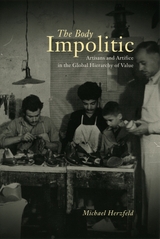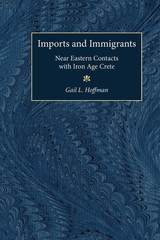5 books about Crete (Greece)

The Body Impolitic
Artisans and Artifice in the Global Hierarchy of Value
Michael Herzfeld
University of Chicago Press, 2003
The Body Impolitic is a critical study of tradition, not merely as an ornament of local and national heritage, but also as a millstone around the necks of those who are condemned to produce it.
Michael Herzfeld takes us inside a rich variety of small-town Cretan artisans' workshops to show how apprentices are systematically thwarted into learning by stealth and guile. This harsh training reinforces a stereotype of artisans as rude and uncultured. Moreover, the same stereotypes that marginalize artisans locally also operate to marginalize Cretans within the Greek nation and Greece itself within the international community. What Herzfeld identifies as "the global hierarchy of value" thus frames the nation's ancient monuments and traditional handicrafts as evidence of incurable "backwardness."
Herzfeld's sensitive observations offer an intimately grounded way of understanding the effects of globalization and of one of its most visible offshoots, the heritage industry, on the lives of ordinary people in many parts of the world today.
Michael Herzfeld takes us inside a rich variety of small-town Cretan artisans' workshops to show how apprentices are systematically thwarted into learning by stealth and guile. This harsh training reinforces a stereotype of artisans as rude and uncultured. Moreover, the same stereotypes that marginalize artisans locally also operate to marginalize Cretans within the Greek nation and Greece itself within the international community. What Herzfeld identifies as "the global hierarchy of value" thus frames the nation's ancient monuments and traditional handicrafts as evidence of incurable "backwardness."
Herzfeld's sensitive observations offer an intimately grounded way of understanding the effects of globalization and of one of its most visible offshoots, the heritage industry, on the lives of ordinary people in many parts of the world today.
[more]

The Documents of Angelo de Cartura and Donato Fontanella
Venetian Notaries in Fourteenth-Century Crete
Alan M. Stahl
Harvard University Press, 2000
This volume, which includes the texts in Latin with an English preface and extensive indices, contains the text of two notarial protocols in the Notai di Candia series of the Archivio di Stato di Venezia. Both notaries were active in the town of Candia, modern Herakleion, in the Venetian colony of Crete in the early fourteenth century.Though the two protocols published here are fragmentary in terms of their survival, and selective in the aspects of life that they record, they are both valuable sources for understanding the lives of Venetian, Greek, and Jewish men and women in fourteenth-century Crete.
[more]

Imports and Immigrants
Near Eastern Contacts with Iron Age Crete
Gail L. Hoffman
University of Michigan Press, 1998
While scholars have long acknowledged the importance of artistic relationships between ancient Greece and the Near East, recent discourse on multi-culturalism and diversity has ignited new debate over these issues both among scholars and in the broader public. Charges and countercharges of historical revisionism and systematic undervaluation of the debt owed by ancient Greece to the Near East and Africa have polarized the debate and obscured the actual evidence. In Imports and Immigrants, Gail L. Hoffman explores the primary archaeological basis for such discussions, namely the preserved physical remains, providing a foundation for constructive discussion of the relations and exchanges between ancient Greece and the Near East.
Drawing together all the evidence and arguments for Near Eastern immigrants in Crete, Hoffman demonstrates there are basic problems with the accepted interpretations. Evidence of continued technical expertise casts doubt on the necessity of reintroduction, while careful scrutiny of the evidence supporting immigrant craftsmen reveals many inadequacies in the currently accepted analyses.
Imports and Immigrants identifies the need for reassessing all dimensions of the question of artistic relationships between ancient Greece and other regions of the Aegean basin and suggests new avenues of inquiry in this important debate. The volume also reassesses arguments made for the presence of Near Eastern immigrants in Crete. This book includes a catalogue indispensable for future work on these issues and illustrations of most of the known imports to Crete.
Gail L. Hoffman is Associate Professor of Greek Art and Archaeology, Department of Classics, Yale University.
Drawing together all the evidence and arguments for Near Eastern immigrants in Crete, Hoffman demonstrates there are basic problems with the accepted interpretations. Evidence of continued technical expertise casts doubt on the necessity of reintroduction, while careful scrutiny of the evidence supporting immigrant craftsmen reveals many inadequacies in the currently accepted analyses.
Imports and Immigrants identifies the need for reassessing all dimensions of the question of artistic relationships between ancient Greece and other regions of the Aegean basin and suggests new avenues of inquiry in this important debate. The volume also reassesses arguments made for the presence of Near Eastern immigrants in Crete. This book includes a catalogue indispensable for future work on these issues and illustrations of most of the known imports to Crete.
Gail L. Hoffman is Associate Professor of Greek Art and Archaeology, Department of Classics, Yale University.
[more]

Paradise Earned
The Bacchic-Orphic Gold Lamellae of Crete
Yannis Tzifopoulos
Harvard University Press, 2010
This is a study of the twelve small gold lamellae from Crete that were tokens for entrance into a golden afterlife: the deceased who were buried or cremated with them believed that they had 'earned Paradise.' The lamellae are placed within the context of a small corpus of similar texts, and published with extensive commentary on their topography, lettering and engraving, dialect and orthography, meter, chronology, and usage. The texts reveal a hieros logos whose poetics and rituals are not much different from Homeric rhapsodizing and prophetic discourses. Cretan contexts, both literary and archaeological, are also brought to bear on these incised objects and on the burial custom involved. Finally, this work adduces parallels to the texts on the lamellae from the Byzantine period and modern Greece to illuminate the everlasting and persistent human quest for 'earning Paradise.'
[more]

Wills from Late Medieval Venetian Crete, 1312–1420
Sally McKee
Harvard University Press, 1998
READERS
Browse our collection.
PUBLISHERS
See BiblioVault's publisher services.
STUDENT SERVICES
Files for college accessibility offices.
UChicago Accessibility Resources
home | accessibility | search | about | contact us
BiblioVault ® 2001 - 2024
The University of Chicago Press









